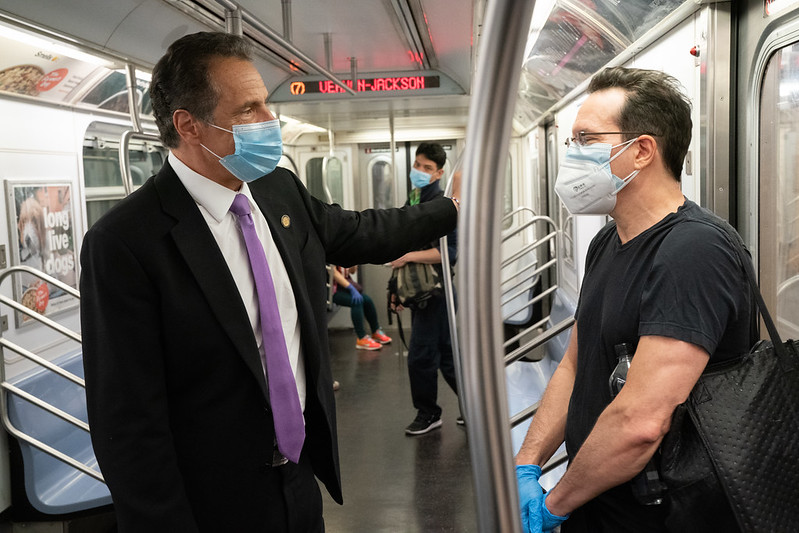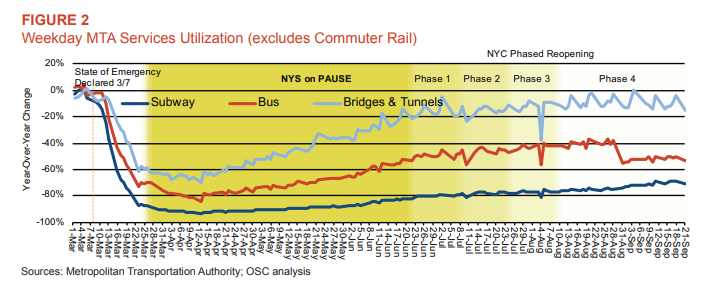
Governor Cuomo on the subway (photo: governor's office)
Hope that Congress can enact a post-election stimulus package to aid the economy amid another explosion of coronavirus cases has narrowed. One major institution in New York, the Metropolitan Transportation Authority (MTA), is now out of time to get help. It is therefore necessary for New York State to step up and rescue the MTA before it begins a series of wrenching cutbacks that could permanently harm the New York region. The agency is being overwhelmed by financial losses due to the pandemic and its impact on the economy.
MTA Chair Patrick Foye, describing the MTA’s desperation, said in a NY1 interview on October 28, that “Our urgent request…to the United States Senate, is for $12 billion, which will take us through 2020…and 2021. That money is desperately needed. If we don’t receive it, our hand may be forced in terms of draconian service reductions, up to 40% on subways and buses, up to 50% on commuter rails, on top of laying off…thousands of our colleagues, plus fare and toll increases above those that are budgeted. This is an apocalyptic scenario.”
He went on to say that the MTA Board would make a decision at its December Board meeting to proceed with the cutbacks in the first quarter of 2021 if Congress didn’t give the MTA the money. He expressed optimism nonetheless.
An October 2020 New York State Comptroller report on the MTA presented the below graph showing the staggering ridership losses for the subways and other parts of the massive transit agency.

The graph shows subway ridership plunging 90% at the start of the pandemic, recovering to an 80% loss as the economy partially reopened by mid-June, and trending up to a still devastating 70% ridership loss from the beginning to mid-September. New York City Comptroller Scott Stringer has been tracking MTA ridership reports and other city economic matters and the most recent ridership numbers show losses are still 63-70% below weekday daily numbers from the year prior. The suburban commuter rail systems are faring badly too.
New York State adopted its 2020-2021 budget in April 2020, just weeks after the declaration of the national and New York COVID-19 emergencies. The state budget anticipated the economic plunge and authorized New York to cut its budget. It also authorized New York to borrow up to $11 billion short-term to adjust to potential massive cash flow problems, some of which stemmed from Congress postponing the April 15 income tax filing deadline to July 15. New York’s large borrowing authorization also permitted conversion of short-term loans into longer repayment periods, including 30-year bonds.
To date, New York State has borrowed $4.5 billion. Current plans are to repay $1 billion by December 31, and the remaining $3.5 billion by March 31, 2021 the end of the current fiscal year, according to the mid-year forecast issued by the State Division of the Budget. New York State is in possession of this cash now.
Governor Cuomo can ask the State Legislature to quickly appropriate this $3.5 billion in cash to the MTA. The state can convert the earlier short-term borrowing into 30-year bonds in the next several months. The state may be proceeding now to repay the other $1 billion and it would not be wise to interfere with any processes underway in relation to that repayment.
The State Comptroller’s Annual MTA Financial Report said the agency faces the greatest financial crisis in its history. The table below from that report shows that in 2020 the MTA has lost nearly $5 billion in fare and toll revenue, and nearly $2 billion in revenue from dedicated taxes and subsidies. Those $7 billion in losses were partially offset by the major federal stimulus package enacted in March, the CARES Act, which gave the MTA $4 billion. The MTA had a modest (a mere $412 million) deficit for 2020 before covid, but its final deficit for 2020 was projected in July to be $3.4 billion.
New York State appropriating $3.5 billion to the MTA now will stem this hemorrhaging for the moment and push the MTA’s crisis into later in 2021, though the MTA will need federal help sooner or later. State action now could help get the MTA to the Biden administration without catastrophe.

Even if the MTA gets the financial relief it needs for 2020, from New York State or the federal government, the table shows it faces a $6.2 billion deficit in 2021. If the economy fails to improve as much as anticipated, or if the huge part of New York City’s employment base now working home continues to do so, the MTA’s revenue losses would be higher and its deficits larger as a result. The MTA may be facing a major long-term restructuring.
The state budget allowed the MTA itself to borrow money, but it has said it simply cannot afford to do so. In fact, to survive into 2021 it must hoard cash. Among the options are deferring pension contributions, deferring Social Security payroll taxes, and halting cash contributions to the capital program. These options will save $3 billion in 2020-2021. The MTA can continue a hiring freeze and work with the labor unions on possible savings.
The 2020-2024 MTA capital program has been temporarily suspended. The centerpiece of revenue for that program, congestion pricing, was not approved by the Trump administration and awaits action from the Biden administration. It will be at least several years before most of this capital program can be started. The MTA will need to focus on finishing the 2015-19 capital plan with the remaining available sources of funds.
Severe health and economic problems other than the MTA confront New Yorkers. If the state is going to rescue the MTA, it could also borrow either short-term or long-term to avoid implementing its planned cutbacks to public services and aid to localities.
The State Division of the Budget’s plan to implement the adopted 2020-2021 budget provided for $8 billion in spending reductions in local assistance, in schools, health care, transportation, and emergency services. In its recently-released mid-year budget update, the Division of Budget reported that by the end of September it had withheld $2.4 billion in local aid, as it awaited the elusive new stimulus package that Congress and the President have failed to enact.
The Department of Budget’s April 25 Financial Plan indicated it would backload 40% of the state’s local assistance cutbacks to the final quarter of the state fiscal year, meaning from January through March 2021. That would represent a $3.2 billion cut to schools, hospitals, and other vital public services. If the state used $3.5 billion in borrowing authority to help the MTA, it could use part of the remaining borrowing authority to halt the cutbacks planned for the final quarter of the 2020-2021 fiscal year. This would mean the state would not be compounding the financial problems of local governments, including New York City, for now.
Sooner or later, Congress will pass another stimulus package that will include more aid for the unemployed, for state and local governments, and for transit agencies. It may be the President Biden stimulus package. But the MTA and New York’s local governments will be reeling by then if New York State does not act now. The state can use some of the funds from Congress to repay loans and cover deficits.
While such action is necessary, it will also remain true that the state, the city, the MTA, and the rest of New York’s local governments will likely confront the reality of continued budget deficits in 2021-2022, and beyond, and the necessity of a full-on restructuring of spending, borrowing, and taxing for years to come. But that likelihood does not negate the importance of state action now.
***
Jim Brennan was a member of the New York State Assembly for 32 years, where he chaired four committees. On Twitter @JimBrennanNY.
***
Have an op-ed idea or submission for Gotham Gazette? Email This email address is being protected from spambots. You need JavaScript enabled to view it.